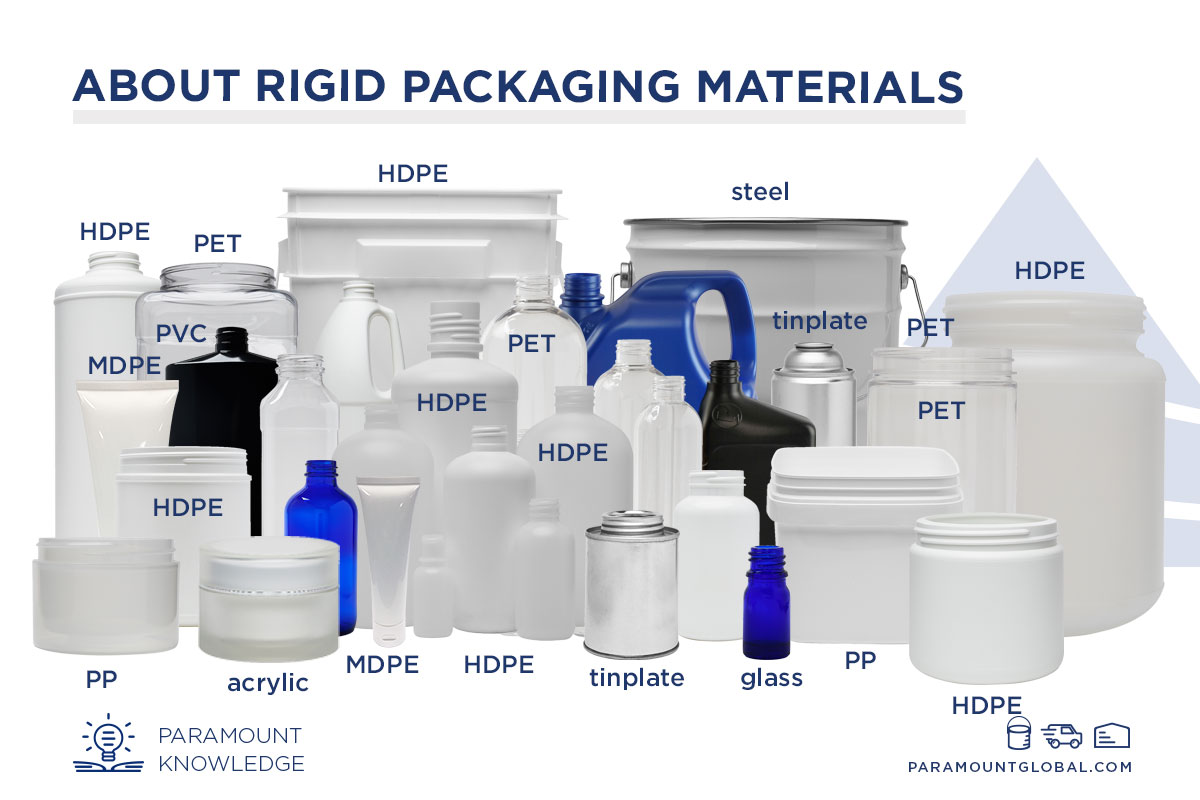KNOWLEDGE
16 Packaging Materials and How to Use Them
The packaging industry is constantly changing and evolving, including the materials used to produce containers and closures. From plastics and glass to fiber or tin, the possibilities seem endless.
Below are some of the most common rigid packaging materials found in the industry:
Acrylic: a popular resin used in the cosmetics and personal care industries, acrylic is known to be more cost-effective than its glass alternative. Acrylic containers are also known to provide an elegant finish.
Aluminum: a lightweight option of metal for forming packaging and closures. Traditionally used in the industrial industry but has entered beverage and personal care markets due to its recyclability.
EVOH (Ethylene-Vinyl Alcohol Copolymers): this thermoplastic has strong barrier properties, making it ideal for packaging in the food, pharmaceutical, nutraceutical, and personal care industries. Because EVOH can lose some of its barrier properties when exposed to moisture, it is common to combine EVOH with other materials such as HDPE, PP, or PET.
Glass: versatile in both colors and shapes, glass containers are recyclable and found across multiple industries. Some of the most common colors in this material are amber, cobalt, flint (clear), and green.
HDPE (High Density Polyethylene): extremely popular due to its durability, HDPE is known to have good barrier properties. Available in many colors, shapes, and sizes, HDPE containers can be stored at temperatures below freezing and used in some hot-filled applications (always check temperature capabilities before filling).
Kraft: a type of chemical wood pulp, kraft is used to make products like cardboard and paperboard. Kraft is also created with other pulp materials, such as bamboo and by-products of crops like corn or rice.
LDPE (Low Density Polyethylene): unlike its counterpart HDPE, LDPE is less rigid and commonly used for flexible packaging. The material is resistant to many acids and oils.
MDPE (Medium Density Polyethylene): this plastic is a middle ground of strength and flexibility between HDPE and LDPE. Various flexibility is achieved by adjusting the ratios of HDPE and LDPE.
PCR (Post Consumer Resin): PCR is considered an eco-friendly packaging option composed of recycled plastics. While the process varies, PCR packaging is made by blending recycled PET or HDPE plastics with virgin material to form products like packers or juice bottles.
PE (Polyethylene): available in an array of densities, polyethylene is the resin that makes up HDPE, LDPE, and MDPE plastics. While it varies depending on the composition, polyethylene is a durable option for various packaging applications.
PET (Polyethylene Terephthalate): a clear and smooth plastic, PET is known to have excellent barrier properties against many gasses, liquids, and most solvents. In addition, the resin has a high shatter resistance and is found in many personal care, food, and beverage applications.
PP (Polypropylene): commonly used to create various caps and closures, polypropylene is a strong plastic with chemical resistant properties. Due to its high melting point, packaging made from this material is suitable for hot-fill applications (always check temperature capabilities before filling).
PS (Polystyrene): in its rigid form, polystyrene is known for its clarity and similar appearance to acrylic and glass. While it has an excellent moisture barrier, it is known to have poor impact durability. This plastic is commonly used to make products such as jars.
PVC (Polyvinyl Chloride): resistant to oxygen, oils, and many chemicals, PVC is a versatile plastic with fair impact resistance.
Steel: a strong alloy composed of iron and carbon, the properties of steel provide high impact resistance and promote the use of steel for larger-volume packaging such as pails and drums.
Tinplate: a metal that is composed of steel with a thin layer of tin to prevent rusting. Tinplate can be used for multiple packaging applications, including various types of containers and closures.

Interested in learning more about the different packaging materials we can provide? Give us a call at 714-690-3000 or fill out our contact form here.
Hayley is a marketing professional and copywriter with a background in crafting content for a diverse range of industries. She has been writing about packaging and supply chain logistics for Paramount Global since 2022. She specializes in explaining complex topics in a clear and engaging way and is an advocate for sustainability in packaging and supply chain management.
Read More
For over forty years, Paramount has been delivering perfectly integrated packaging and supply chain solutions.
